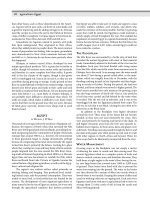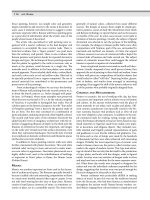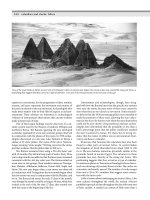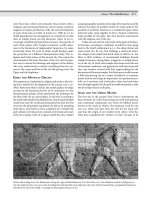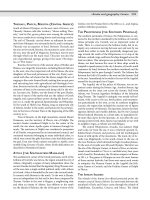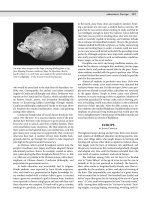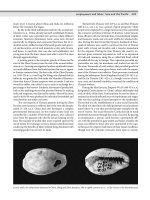Encyclopedia of society and culture in the ancient world ( PDFDrive ) 955
Bạn đang xem bản rút gọn của tài liệu. Xem và tải ngay bản đầy đủ của tài liệu tại đây (65.22 KB, 1 trang )
882
resistance and dissent: further reading
experienced by Teotihuacán by having even their kings endure
the same privations as the poor. Kings and nobles wore better clothes, had better housing, and had their pick of the best
food, but they lived among their people and starved when their
community starved and suffered from war when their people
suffered from war. Indeed, kings and nobles were expected to
be among the first to risk their lives when they waged war.
Even so, people sometimes became angry with their government. Mayan culture provided an outlet for this: Groups
of people could shift their allegiance to another city or just
pick up their belongings and move away. When they shifted
allegiance to another city, they did so as groups. Probably
under the leadership of local elders or a local governor, they
would reallocate whole villages or community farmlands
to a neighboring city-state, making its king their king and
sending their taxes to their new government. This would have
made them subject to raiding for slaves and human sacrifices
by their old government, so they would have needed to join
a city-state that was willing and able to protect them. In the
absence of such a government, entire villages or groups of villages would sometimes abandon their homes and carry what
they could to a new place out of reach of their former government. Such movements may explain why certain styles of
pottery would mix with another style from a region far away,
resulting in the creation of a new style or the loss of one style
as the other became dominant.
Violence arose when cities tried to throw off the dominance of another city. Both Tikal and Calakmul experienced
repeated revolts as the nobility of smaller cities tried to end the
paying of tribute to those cities. Such revolts were very risky; if
the rebels were captured, they would be tortured for days and
then ritually sacrificed. If the commoners of the rebel cities
believed they endured too much misery because of the revolt,
they could shift allegiances or pick up and leave, which they
sometimes did. Further, when a city’s monarch was replaced
by force, people might resist his orders. In 378 c.e. a noble
from Teotihuacán, Siyaj K’ak’, killed the king of Tikal and
made himself king of the city. Depictions of Siyaj K’ak’ show
him in Teotihuacán clothing and armor, but his successors are
pointedly in Tikal garb; in one depiction a later king’s Mayan clothing contrasts with Siyaj K’ak’s Teotihuacán clothing,
a public effort to distance the monarch from his ancestor by
showing that he was committed to Tikal’s traditions.
For South America little is known about dissent and resistance of the ancient era, except that resistance could bring
terrifying consequences. The Moche (ca. 100–ca. 600 c.e.)
of Peru left murals that show the cost of resisting its rulers.
Whether rebels or prisoners of war, the fate was torture and
then mass bloodlettings, during which a priest sliced open
the throats one at a time of hundreds of prisoners, all in a
public display during which the prisoners had to watch what
was happening. To risk such a fate, people had to be highly
motivated and prepared to die rather than be captured. Perhaps dissidents among the Moche did as the Maya sometimes
did and, if they could, moved away.
See also agriculture; architecture; art; borders and
frontiers; ceramics and pottery; cities; crime and
punishment; empires and dynasties; foreigners and
barbarians; government organization; hunting, fishing, and gathering; laws and legal codes; literature;
migration and population movements; military; religion and cosmology; scandals and corruption; settlement patterns; social organization; towns and
villages; trade and exchange; war and conquest;
writing.
FURTHER READING
Julius Caesar, The Gallic War, trans. H. J. Edwards (Cambridge,
Mass.: Harvard University Press, 1917).
Hans Delbrück, History of the Art of War within the Framework of
Political History, Vol. 2, The Germans, trans. Walter J. Renfroe
(Westport, Conn.: Greenwood, 1980).
Nikolai Grube, ed., Maya: Divine Kings of the Rain Forest (Cologne,
Germany: Könemann, 2001).
Peter Gwin, “Peruvian Temple of Doom,” National Geographic 206
(July 2004): 102–117.
Adetokundbo F. Knowles-Borishade, “Paradigm for Classical African Orature,” Journal of Black Studies 21 (1991): 488–500.
Andrew W. Lintott, Violence, Civil Strife, and Revolution in the
Classical City, 750–330 b.c. (Baltimore, Md.: Johns Hopkins
University Press, 1982).
Josiah Ober, Political Dissent in Democratic Athens: Intellectual
Critics of Popular Rule (Princeton, N.J.: Princeton University
Press, 1998).
J. N. Postgate, “Royal Ideology and State Administration in Sumer
and Akkad.” In Civilizations of the Ancient Near East, ed. Jack
M. Sasson (New York: Scribner, 1995).
Donald B. Redford, Akhenaten: The Heretic King, repr. ed. (Princeton, N.J.: Princeton University Press, 1987).
John. F. Robertson, “Social Tensions in the Ancient Near East.” In A
Companion to the Ancient Near East, ed. Daniel C. Snell (Malden, Mass.: Blackwell, 2005).
Isidor F. Stone, The Trial of Socrates (Boston: Little, Brown, 1988).
Tacitus, The Agricola and The Germania, trans. S. A. Handford and
H. Mattingly (New York: Penguin, 1971).
Peter S. Wells, The Barbarians Speak: How the Conquered Peoples
Shaped Roman Europe (Princeton, N.J.: Princeton University
Press, 1999).
Peter S. Wells, The Battle That Stopped Rome: Emperor Augustus,
Arminius, and the Slaughter of the Legions in the Teutoburg
Forest (New York: W. W. Norton, 2003).
▶ roads and bridges
introduction
The earliest roads in the ancient world consisted of tracks
made by game animals and migrating herds. Ancient huntergatherers followed these tracks in pursuit of game and used
them to travel from one place to another. In time, however,
more sophisticated roadways were built, and the extent and
quality of some of these roads might come as a surprise to
